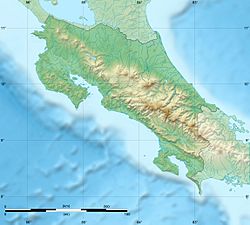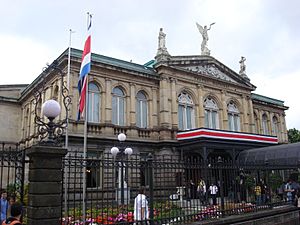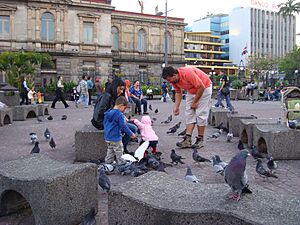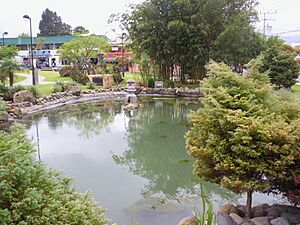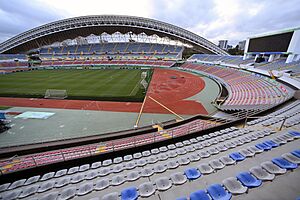San José, Costa Rica facts for kids
Quick facts for kids
San José
|
|||||
|---|---|---|---|---|---|
| Ciudad de San José de Costa Rica | |||||
|
Skyline of San José in 2023
La Sabana Park
southeastern face of the National Museum
National Theatre
Morazán Park
the Edificio Metálico
entrance of the National Museum
Paseo Colón avenue
Metropolitan Cathedral
|
|||||
|
|||||
| Nickname(s):
Chepe ("Joe")
|
|||||
| Motto(s): | |||||

Borders of San José city within San José canton, where East sector of Uruca district is excluded.
|
|||||
| Country | |||||
| Province | |||||
| Founded | c. 1739 | ||||
| Capital as of | 16 May 1823 | ||||
| Districts | 10 total, 1 partial. | ||||
| Area | |||||
| • Capital city | 44.62 km2 (17.23 sq mi) | ||||
| • Metro | 2,044 km2 (789 sq mi) | ||||
| Elevation | 1,172 m (3,845 ft) | ||||
| Population
(2022)
|
|||||
| • Capital city | 352,381 | ||||
| • Density | 7,897.4/km2 (20,454.1/sq mi) | ||||
| • Urban | 1,543,000 (March 2,013) | ||||
| • Metro | 2,158,898 | ||||
| • Metro density | 1,056.2/km2 (2,736/sq mi) | ||||
| • Demonym | Josefino/a | ||||
| GDP (PPP, constant 2015 values) | |||||
| • Year | 2023 | ||||
| • Metro | $30.2 billion | ||||
| • Per capita | $20,700 | ||||
| Time zone | UTC-6 (CST) | ||||
| Area code(s) | + 506 | ||||
| HDI (2019) | 0.828 Very High |
||||
| Climate | Aw | ||||
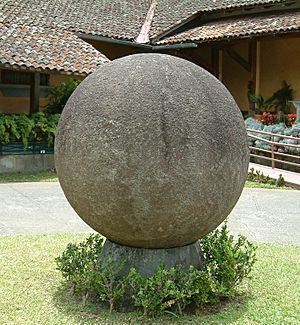
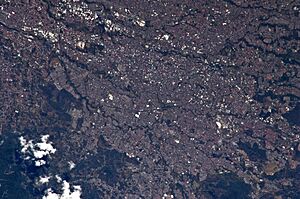
San José (meaning "Saint Joseph") is the exciting capital and largest city of Costa Rica. It is also the capital of San José Province. You can find it right in the middle of the country, in the beautiful Central Valley.
San José is super important because it's where Costa Rica's government is located. It's also a major center for business and travel. The city itself is a canton, covering about 44.62 square kilometers (17.23 square miles). In 2022, around 352,381 people lived there.
When you combine San José with nearby cities like Alajuela, Heredia, and Cartago, it forms the Greater Metropolitan Area. This huge area is home to over 2 million people! The city gets its name from Joseph of Nazareth.
San José was started around 1736. It has been the capital of Costa Rica three times! Today, more than a million people visit or pass through it every day. It's home to cool places like the Museo Nacional de Costa Rica, the National Theatre of Costa Rica, and La Sabana Metropolitan Park. If you fly there, you'll likely arrive at Juan Santamaría International Airport.
People often say San José has a high quality of life. It's known for being safe, modern, and having good public services. In 2012, it was one of the safest cities in its region. San José is also part of the UNESCO Global Network of Learning Cities, which means it's a great place for education.
Contents
History of San José
The city of San José grew in a unique way during the 1700s. It wasn't planned like most Spanish cities in Central America.
It was founded in 1736 by the Cabildo de León. Their goal was to bring together people who were living spread out in the Aserrí Valley. So, they ordered a small chapel to be built near an area called La Boca del Monte. This chapel was finished a year later. That's when Saint Joseph was chosen as the city's patron saint, giving the city its name.
Unlike its neighbor Cartago, San José didn't start with a formal city government. It wasn't until 1812, with the new Constitution of Cádiz, that San José got its first local government. In 1813, it was officially called a city. However, this title was lost in 1814 when the king of Spain canceled some laws. The city government and title were brought back in 1820. Then, in 1823, San José officially became the capital of Costa Rica. This makes San José one of the newest capital cities in Latin America.
The city grew a lot when people got better access to water and a tobacco factory opened in 1782. Growing tobacco brought a lot of money to the city, helping it become richer than other nearby areas.
The first modern neighborhood, Barrio Amon, was built in the late 1800s. It was named after a French coffee businessman, Monsieur Amon. This area, along with the National Theatre, shows the "golden age" of Costa Rican coffee.
Today, San José is a busy, modern city with lots of shops, art, and cool buildings. It's a popular place for tourists to visit and a great starting point for exploring Costa Rica.
City Districts
San José is divided into several areas called districts. The city's official borders include most of the San José canton.
The city is made up of all of these districts:
- Carmen
- Merced
- Hospital
- Catedral
- Zapote
- San Francisco de Dos Ríos
- Mata Redonda
- Pavas
- Hatillo
- San Sebastián
It also includes part of the Uruca district.
Population and People
| Historical population | |||
|---|---|---|---|
| Census | Pop. | %± | |
|
Instituto Nacional de Estadística y Censos |
|||
In 2022, San José had about 352,381 people living there. This is more than any other canton in Costa Rica. In 2011, the population was 288,054, so it has grown quite a bit!
Most people live in the districts around the city center. The downtown districts (Carmen, Merced, Hospital, and Catedral) are often called the casco central. Only about 18% of the canton's population lives in these central areas.
In 2022, there were slightly more men than women in the canton. Almost all of the population lives in urban areas. About 17% of the people are under ten years old, and about 7.67% are over 65.
Climate and Weather
San José has a tropical wet and dry climate. This means it has a rainy season and a dry season. The amount of rain changes a lot between the driest month (about 6.3 mm) and the wettest month (about 355.1 mm).
The average temperatures don't change much throughout the year. April is usually the warmest month, with an average temperature of about 23.7°C (74.7°F). October is the coolest month, with an average of about 21.8°C (71.2°F).
| Climate data for San José (Juan Santamaría International Airport) | |||||||||||||
|---|---|---|---|---|---|---|---|---|---|---|---|---|---|
| Month | Jan | Feb | Mar | Apr | May | Jun | Jul | Aug | Sep | Oct | Nov | Dec | Year |
| Record high °C (°F) | 31.5 (88.7) |
33.3 (91.9) |
33.4 (92.1) |
34.5 (94.1) |
33.3 (91.9) |
32.1 (89.8) |
31.7 (89.1) |
32.0 (89.6) |
32.0 (89.6) |
31.4 (88.5) |
30.9 (87.6) |
31.7 (89.1) |
34.5 (94.1) |
| Mean daily maximum °C (°F) | 28.2 (82.8) |
29.1 (84.4) |
29.9 (85.8) |
30.3 (86.5) |
28.8 (83.8) |
28.2 (82.8) |
28.2 (82.8) |
28.3 (82.9) |
27.8 (82.0) |
27.1 (80.8) |
27.2 (81.0) |
27.9 (82.2) |
28.4 (83.1) |
| Daily mean °C (°F) | 22.6 (72.7) |
23.0 (73.4) |
23.5 (74.3) |
23.7 (74.7) |
22.9 (73.2) |
22.5 (72.5) |
22.6 (72.7) |
22.4 (72.3) |
22.0 (71.6) |
21.8 (71.2) |
21.9 (71.4) |
22.3 (72.1) |
22.6 (72.7) |
| Mean daily minimum °C (°F) | 18.5 (65.3) |
18.7 (65.7) |
18.8 (65.8) |
19.1 (66.4) |
19.2 (66.6) |
19.0 (66.2) |
19.0 (66.2) |
18.8 (65.8) |
18.3 (64.9) |
18.5 (65.3) |
18.3 (64.9) |
18.3 (64.9) |
18.7 (65.7) |
| Record low °C (°F) | 11.7 (53.1) |
13.2 (55.8) |
14.5 (58.1) |
14.9 (58.8) |
14.4 (57.9) |
15.8 (60.4) |
15.2 (59.4) |
16.0 (60.8) |
15.8 (60.4) |
15.3 (59.5) |
14.5 (58.1) |
14.2 (57.6) |
11.7 (53.1) |
| Average rainfall mm (inches) | 6.3 (0.25) |
10.2 (0.40) |
13.8 (0.54) |
79.9 (3.15) |
267.6 (10.54) |
280.1 (11.03) |
181.5 (7.15) |
276.9 (10.90) |
355.1 (13.98) |
330.6 (13.02) |
135.5 (5.33) |
33.5 (1.32) |
1,971 (77.61) |
| Average rainy days (≥ 0.1 mm) | 3 | 3 | 5 | 10 | 23 | 22 | 20 | 22 | 26 | 25 | 17 | 8 | 184 |
| Average relative humidity (%) | 68 | 68 | 66 | 70 | 77 | 83 | 80 | 83 | 85 | 87 | 79 | 74 | 77 |
| Mean monthly sunshine hours | 285.2 | 266.0 | 282.1 | 240.0 | 182.9 | 144.0 | 151.9 | 158.1 | 147.0 | 161.2 | 177.0 | 244.9 | 2,440.3 |
| Source 1: Deutscher Wetterdienst | |||||||||||||
| Source 2: NOAA (sun 1961–1990) | |||||||||||||
Education in San José
Costa Rica has a very good education system. In 2011, almost 98% of people over 10 could read and write. About 96% of kids aged 6-11 go to primary school, and 71% of high school-aged students attend high school. Costa Rica has the best education levels in Central America and one of the best in Latin America.
San José is especially important for education. It has many public and private universities. The first university in Costa Rica, the University of Santo Tomas, was founded here in 1843. Later, in 1940, the modern University of Costa Rica (UCR) was established. The University for Peace, created by the United Nations, is also in San José.
The city's public schools include pre-schools, elementary schools, and high schools (grades 7 to 11). These are found in all parts of the city and are managed by the Ministry of Public Education. There are also many private schools and universities. Many of these private schools are bilingual, teaching subjects in English or French, as well as Spanish.
Safety and Security
San José is known as one of the safest cities in Latin America. In 2012, the city and the country worked hard to reduce crime rates. Crime incidents per 100,000 people dropped significantly.
The government has invested in new police equipment and increased the security budget. This helps keep the city safe for everyone.
Major Landmarks and Attractions
San José has many famous buildings and places to visit.
Theaters and Performance Halls
San José has several beautiful theaters, many with European-style architecture. These buildings are popular tourist spots. People love their design and the cultural shows they host, which include traditional and modern Costa Rican performances.
The most famous theaters are:
- The National Theater of Costa Rica: This is considered the most beautiful historic building in the capital. It's known for its fancy interior with Italian furnishings.
- The Melico Salazar Theater.
- The National Auditorium at the Children's Museum of Costa Rica.
These theaters host plays, dance shows, and concerts all year. There are also many smaller theaters throughout the city offering different kinds of entertainment. El Teatro Variedades, built in 1892, is the oldest theater in San José.
Museums to Explore
San José is also home to many interesting museums. These museums let visitors learn about Costa Rican history, scientific discoveries, ancient cultures, and modern art. The city even has a museum dedicated to gold and another to jade!
Some of the main museums include:
- The Children's Museum (Museo de los Niños)
- The National Museum of Costa Rica (Museo Nacional de Costa Rica)
- The Museum of Pre-Columbian Gold (Museo de Oro Precolombino)
- The Museum of Costa Rican Art
- The Museum of Contemporary Art and Design (Museo de Arte y Diseño Contemporáneo)
- The Museum of Jade (Museo del Jade Marco Fidel Tristán Castro)
Parks, Plazas, and Zoos
San José has many parks and squares, called plazas. Here, you can find pretty gazebos, open green spaces, and places to relax. Many parks have lakes, fountains, and sculptures by local artists. You can also see many different birds, trees, and plants.
Top Parks and Zoos
The city's main parks include:
- The National Park (Parque Nacional)
- Morazán Park (Parque Morazán): This park has a beautiful Neoclassical Temple of Music.
- [[La Sabana Metropolitan Park|La Sabana Metropolitan Park (Parque Metropolitano La Sabana)]: This is the largest park and is often called "the lungs of San José."
- Peace Park (Parque de la Paz)
- Okayama Park (Parque Okayama): This park has a Japanese-style garden with ponds and sculptures.
- Simón Bolívar Zoo: This is the city's only zoo. It has many native Costa Rican animals and exotic species.
Popular Plazas
Plazas, or town squares, are very common in San José. They are great places to meet friends or just relax.
- Plaza de la Democracia
- Culture Square (La Plaza de La Cultura)
Getting Around San José
San José has many ways to get around, both within the city and to other parts of Costa Rica. The city is working on making its transportation even better. In 2011, there were plans to build a tramway system to connect the central parts of the city.
In 2012, San José also started putting up its first street signs! Before this, it was hard to find places because many streets didn't have names.
Roads and Highways
Several important national roads go through the city. These roads connect San José to other areas.
 National Route 1
National Route 1 National Route 2
National Route 2 National Route 3
National Route 3 National Route 27
National Route 27 National Route 39
National Route 39 National Route 100
National Route 100 National Route 101
National Route 101 National Route 104
National Route 104 National Route 108
National Route 108 National Route 110
National Route 110 National Route 167
National Route 167 National Route 174
National Route 174 National Route 175
National Route 175 National Route 176
National Route 176 National Route 177
National Route 177 National Route 204
National Route 204 National Route 207
National Route 207 National Route 209
National Route 209 National Route 211
National Route 211 National Route 213
National Route 213 National Route 214
National Route 214 National Route 215
National Route 215 National Route 218
National Route 218
Buses for Travel
Private bus companies help people travel between different parts of the city and to the suburbs. Other companies offer bus services to other parts of Costa Rica, with stations located around the city center. There are also bus services that go between Juan Santamaría International Airport and downtown San José.
Train Services
The Instituto Costarricense de Ferrocarriles, which is the state-owned railway company, manages all of Costa Rica's trains. In 2004, they started building a train network to connect different urban areas. This network would link places like Tibás, Heredia, San Antonio de Belén, Pavas, San Pedro de Montes de Oca, Sabanilla, and Curridabat.
There are also plans to make this train system even bigger, connecting to Cartago, Alajuela, and the Juan Santamaría International Airport.
Taxis and Ride-Sharing
Red taxis are a common way to get around San José. These taxis belong to official groups. You might also see orange taxis, which are usually for airport travel.
The car-sharing company Uber also operates in Costa Rica.
Airports Near San José
The main airport for San José is Juan Santamaría International Airport (SJO). It's about 23 kilometers (14 miles) west of downtown, in the city of Alajuela. This is one of the busiest airports in Central America. In 2011, it was even named the 3rd Best Airport in Latin America/Caribbean! In 2023, over 5.6 million passengers used this airport, mostly for international flights.
The airport is currently being updated and modernized.
Another important airport is Tobías Bolaños International Airport (SYQ). It's about 8 kilometers (5 miles) northwest of the city center.
Delicious Cuisine
Costa Rican food, called comida típica ("traditional food"), is usually not spicy. In San José, the most popular dish is Gallo pinto ("painted chicken"). This is a mix of black beans and white rice. People often eat gallo pinto for breakfast with tortillas and natilla, which is a thin sour cream.
Restaurants that serve traditional food at good prices are called sodas. They often offer big meals called casados for lunch and dinner. A casado (meaning "married man") usually has rice, beans, meat, a cabbage-and-tomato salad, fried plantains, and tortillas. The San José Central Market in downtown San José is a great place to find many food stalls and sodas.
Sports in the City
The city's main football (soccer) club is Deportivo Saprissa. They have won a record 36 league titles! The team plays its home games at the Estadio Ricardo Saprissa Aymá in Tibas. Another top team, Universidad, plays at the Estadio Ecológico.
San José also hosted the 2015 FIBA COCABA Championship for basketball. The Costa Rica national basketball team finished second in that tournament. The games were held at the Gimnasio Nacional.
Sister Cities Around the World
San José has many sister cities all over the world. This means they have special friendly relationships with these cities.
|
|
|
See also
 In Spanish: San José (Costa Rica) para niños
In Spanish: San José (Costa Rica) para niños














